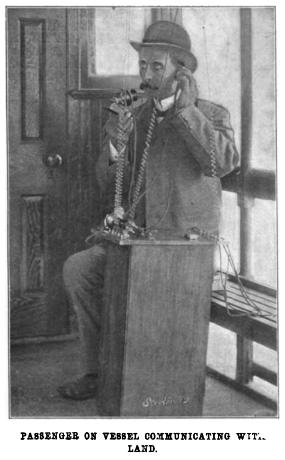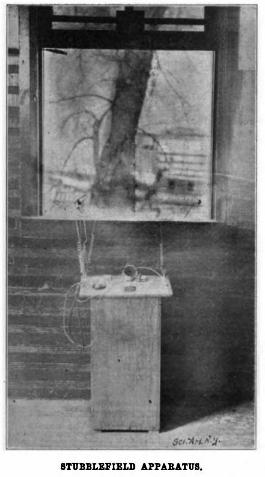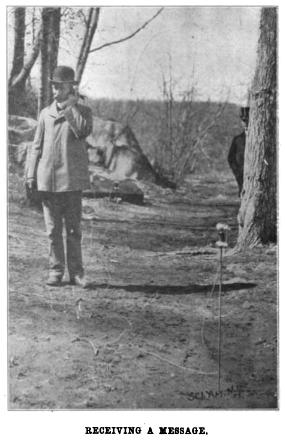http://earlyradiohistory.us/1902stb.htm
Scientific American, May 24, 1902, page 363:
THE LATEST ADVANCE IN WIRELESS TELEPHONY.
BY WALDON FAWCETT.

The latest and one of the most interesting systems of wireless communication with which experiments have recently been conducted is the invention of Nathan Stubblefield, of Murray, Ky., an electrical engineer who is the patentee of a number of devices both in this country and abroad. The Stubblefield system differs from that originated by Marconi in that utilization is made of the electrical currents of the earth instead of the ethereal waves employed by the Italian inventor, and which, by the way, it is now claimed, are less powerful and more susceptible to derangement by electrical disturbances than the currents found in the earth and water. In this new system, however, as in that formulated by Marconi, a series of vibrations is created, and what is known as the Hertzian electrical wave currents are used.
The key to the methods which form the basis of all the systems of wireless telephony recently discovered--the fundamental principles of wireless telephony, as it were--was discovered at Cambridge, Mass., in 1877 by Prof. Alexander Graham Bell, the inventor of the telephone system which bears his name. On the occasion mentioned Prof. Bell was experimenting to ascertain how slight a ground connection could be had with the telephone. Two pokers had been driven into the ground about fifty feet apart, and to these were attached two wires leading to an ordinary telephone receiver. Upon placing his ear to the receiver, Prof. Bell was surprised to hear quite distinctly the ticking of a clock, which after a time he was able to identify, by reason of certain peculiarities in the ticking, as that of the electrical timepiece at Cambridge University, the ground wire of which penetrated the earth at a point more than half a mile distant.

Some five years later Prof. Bell made rather extensive experiments along this same line of investigation at points on the Potomac River near Washington, but these tests were far from satisfactory. It was found on this occasion that musical sounds transmitted by the use of a "buzzer" could be heard distinctly four miles distant, but little success was attained in the matter of communicating the sound of the human voice. Meanwhile Sir William Preece, of England, had undertaken experimental study of the subject of wireless telephony, and during an interval when cable communication between the Isle of Wight and the mainland was suspended, succeeded in transmitting wireless messages to Queen Victoria at Osborne by means of the earth and water electrical currents.
Mr. Stubblefield's experiments with wireless telephony dated from his invention of an earth cell several years ago. This cell derived sufficient electrical energy from the ground in the vicinity of the spot where it was buried to run a small motor continuously for two months and six days without any attention whatever.
Indeed, the electrical current was powerful enough to run a clock and several small pieces of machinery and to ring a large gong. Mr. Stubblefield's first crude experiments looking to actual wireless transmission of the sound of the human voice were made without ground wires. Nevertheless, by means of a cumbersome and incomplete machine, without an equipment of wires of any description, messages were transmitted through a brick wall and several walls of lath and plaster. As the development of the system progressed, the present method of grounding the wires was adopted, in order to insure greater power in transmission. 
The apparatus which has been used in the most recent demonstrations of the Stubblefield system, and which will be installed by the Gordon Telephone Company, of Charleston, S. C., for the establishment of telephonic communication between the city of Charleston and the sea islands lying off the coast of South Carolina, consists primarily of an ordinary receiver and transmitter and a pair of steel rods with bell-shaped attachments which are driven into the ground to a depth of several feet at any desired point, and which are connected by twenty or thirty feet of wire to the electrical apparatus proper. This latter consists of dry cells, a generator and an induction coil, and the apparatus used in most of the experiments thus far made has been incased in a box twelve inches in length, eight inches wide and eighteen inches in height. This apparatus has demonstrated the capability of sending out a gong signal as well as transmitting voice messages, and this is, of course, of great importance in facilitating the opening of communication.
The most interesting tests of the Stubblefield system have been made on the Potomac River near Washington. During the land tests complete sentences, figures, and music were heard at a distance of several hundred yards, and conversation was as distinct as by the ordinary wire telephone. Persons, each carrying a receiver and transmitter with two steel rods, walking about at some distance from the stationary station were enabled to instantly open communication by thrusting the rods into the ground at any point. An even more remarkable test resulted in the maintenance of communication between a station on shore and a steamer anchored several hundred feet from shore. Communication between the steamer and shore was opened by dropping the wires from the apparatus on board the vessel into the water at the stern of the boat. The sounds of a harmonica played on shore were distinctly heard in the three receivers attached to the apparatus on the steamer, and singing, the sound of the human voice counting numerals, and ordinary conversation were audible. In the first tests it was found that conversation was not always distinct, but this defect was remedied by the introduction of more powerful batteries. A very interesting feature brought out during the tests mentioned was found in the capability of this form of apparatus to send simultaneous messages from a central distributing station over a very wide territory.
Extensive experiments in wireless telephony have also been made by Prof. A. Frederick Collins, an electrical engineer of Philadelphia, whose system differs only in minor details from that introduced by Mr. Stubblefield. In the Collins system, instead of utilizing steel rods, small zinc-wire screens are buried in the earth, one at the sending and another at the receiving station. A single wire connects the screen with the transmitting and receiving apparatus, mounted on a tripod immediately over the shallow hole in which the screen is stationed. With the Collins system communication has been maintained between various parts of a large modern office building, and messages have been transmitted without wires across the Delaware River at Philadelphia, a distance of over a mile.